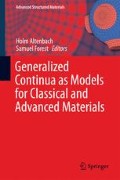Abstract
This article is focused on the identification of the size of the representative volume element (RVE) and the estimation of the relevant effective elastic moduli for particulate random composites modeled as micropolar continua. To this aim, a statistically-based scale-dependent multiscale procedure is adopted, resorting to a homogenization approach consistent with a generalized Hill’s type macrohomogeneity condition. At the fine level the material has two phases (inclusions/matrix). Two different cases of inclusions, either stiffer or softer than the matrix, are considered. By increasing the scale factor, between the size of intermediate control volume elements (Statistical Volume Elements, SVEs) and the inclusions size, series of boundary value problems are numerically solved and hierarchies of macroscopic elastic moduli are derived. The constitutive relations obtained are grossly isotropic and are represented in terms of classical bulk, shear and micropolar bending moduli. The “finite size scaling” of these relevant elastic moduli for the two different material contrasts (ratio of inclusion to matrix moduli) is reported. It is shown that regardless the scaling behavior, which depends on the material phase contrast, the RVE size is statistically detected. The results of the performed numerical simulations also highlight the importance of taking into account the spatial randomness of inclusions which intersect the SVEs boundary.
Access this chapter
Tax calculation will be finalised at checkout
Purchases are for personal use only
References
Addessi D, De Bellis ML, Sacco E (2015) A micromechanical approach for the cosserat modeling of composites. Meccanica 51(3):569–592
Altenbach H, Eremeyev VA (2013) Cosserat media. In: Altenbach H, Eremeyev V (eds) Generalized continua from the theory to engineering application, CISM courses and lectures, vol 541. Springer, Berlin, pp 65–129
Bouyge F, Jasiuk I, Ostoja-Starzewski M (2001) A micromechanically based couple-stress model of an elastic two-phase composite. Int J Solids Struct 38:1721–1735
De Bellis ML, Addessi D (2011) A Cosserat based multi-scale model for masonry structures. Int J Multiscale Comput Eng 9(5):543–563
Eremeyev VA, Lebedev LP, Altenbach H (2012) Foundations of micropolar mechanics. Springer Science and Business Media, Heidelberg
Forest S, Sab K (1998) Cosserat overall modeling of heterogeneous materials. Mech Res Commun 25:449–454
Forest S, Dendievel R, Canova GR (1999) Estimating the overall properties of heterogeneous cosserat materials. Model Simul Materials Sci Eng 7:829–840
Forest S, Pradel F, Sab K (2001) Asymptotic analysis of heterogeneous Cosserat media. Int J Solids Struct 38:4585–4608
Gitman IM, Askes H, Sluys L (2007) Representative volume: existence and size determination. Eng Fract Mech 74:2518–2534
Khisaeva Z, Ostoja-Starzewski M (2006) On the size of RVE in finite elasticity of random composites. J Elast 85:153–173
Li X, Liu Q (2009) A version of Hill’s lemma for Cosserat continuum. Acta Mech Sinica 25:499–506
Onck PR (2002) Cosserat modeling of cellular solids. Comptes Rendus Mec 330:717–722
Ostoja-Starzewski M (2006) Material spatial randomness: from statistical to representative volume element. Prob Eng Mech 21:112–132
Ostoja-Starzewski M (2008) Microstructural randomness and scaling in mechanics of materials., CRC series: modern mechanics and mathematicsTaylor & Francis, Boca Raton
Ostoja-Starzewski M (2011) Macrohomogeneity condition in dynamics of micropolar media. Arch Appl Mech 81:899–906
Ostoja-Starzewski M, Du X, Khisaeva Z, Li W (2007) Comparisons of the size of representative volume element in elastic, plastic, thermoelastic, and permeable random microstructures. Int J Multiscale Comput Eng 5:73–82
Pau A, Trovalusci P (2012) Block masonry as equivalent micropolar continua: the role of relative rotations. Acta Mech 223(7):1455–1471
Ranganathan S, Ostoja-Starzewski M (2008) Scale-dependent homogenization of inelastic random polycrystals. ASME J Appl Mech 75:1–9
Sab K, Nedjar B (2005) Periodization of random media and representative volume element size for linear composites. Comptes rendus de l’Academie des Sciences-Mecanique 333:187–195
Sadowski T, Trovalusci P (2014) Multiscale modeling of complex materials: phenomenological, theoretical and computational aspects. No. 556 in courses and lectures, CISM (International Centre for Mechanical Sciences), Springer, Vienna
Terada K, Hori T, Kyoya T, Kikuchi N (2000) Simulation of the multi-scale convergence in computational homogenization approach. Int J Solids Struct 37:2285–2311
Trovalusci P (ed) (2015) Multiscale and multifield modeling and simulation. Materials with internal structure. Springer Tracts in Mechanical Engineering, Springer Int. Publishing, Switzerland, Heidelberg
Trovalusci P, Masiani R (1999) Material symmetries of micropolar continua equivalent to lattices. Int J Solids Struct 36(14):2091–2108
Trovalusci P, Masiani R (2005) A multi-field model for blocky materials based on multiscale description. Int J Solids Struct 42:5778–5794
Trovalusci P, Pau A (2014) Derivation of microstructured continua from lattice systems via principle of virtual works. The case of masonry-like materials as micropolar, second gradient and classical continua. Acta Mech 225(1):157–177
Trovalusci P, Capecchi D, Ruta G (2009) Genesis of the multiscale approach for materials with microstructure. Arch Appl Mech 79:981–997
Trovalusci P, De Bellis ML, Ostoja-Starzewski M, Murrali A (2014) Particulate random composites homogenized as micropolar materials. Meccanica 49(9):2719–2727
Trovalusci P, Ostoja-Starzewski M, De Bellis ML, Murrali A (2015) Scale-dependent homogenization of random composites as micropolar continua. Eur J Mech A/Solids 49:396–407
Author information
Authors and Affiliations
Corresponding author
Editor information
Editors and Affiliations
Rights and permissions
Copyright information
© 2016 Springer International Publishing Switzerland
About this chapter
Cite this chapter
Trovalusci, P., De Bellis, M.L., Ostoja-Starzewski, M. (2016). A Statistically-Based Homogenization Approach for Particle Random Composites as Micropolar Continua. In: Altenbach, H., Forest, S. (eds) Generalized Continua as Models for Classical and Advanced Materials. Advanced Structured Materials, vol 42. Springer, Cham. https://doi.org/10.1007/978-3-319-31721-2_20
Download citation
DOI: https://doi.org/10.1007/978-3-319-31721-2_20
Published:
Publisher Name: Springer, Cham
Print ISBN: 978-3-319-31719-9
Online ISBN: 978-3-319-31721-2
eBook Packages: EngineeringEngineering (R0)

